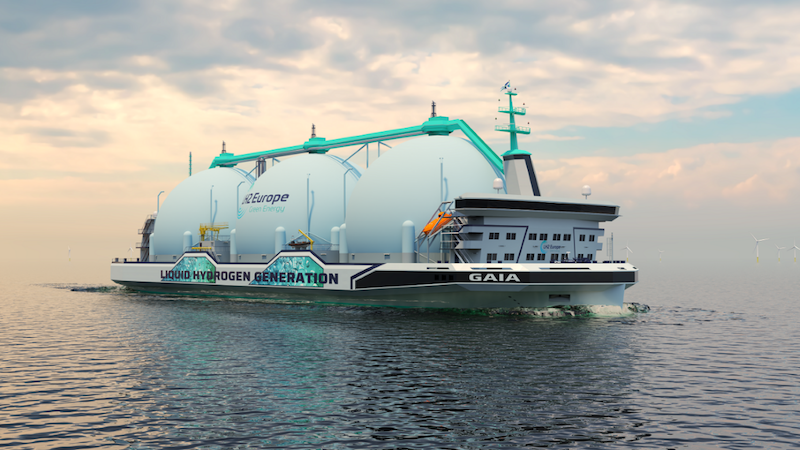Netherlands-based C-Job Naval Architects have designed a new class of liquid hydrogen tanker that the company says will revolutionize the renewable energy market.
The tanker concept, developed in partnership with LH2 Europe, also based in The Netherlands, is a critical element in realizing a green end-to-end liquid hydrogen supply chain, the companies said..
LH2 Europe said it will use the abundant renewable electricity in Scotland to produce green hydrogen and market it at a competitive price with diesel. The new tanker will transport the liquid hydrogen to terminals in Germany, with the goal of expanding supply to other markets as demand increases.
“Hydrogen will be essential to the future of energy. It is up to us how quickly we can make that happen. LH2 Europe aims to have a full liquid hydrogen supply chain ready by 2027,” Dr. Peter Wells, CEO of LH2 Europe, said in a statement. “We plan to initially deliver 100 tons per day (t/d) of green hydrogen and ramp up production to 300 t/d within three years, depending on demand.
“This tanker design is a key step in providing the infrastructure to make that clean energy future a reality," he continued. "Current vessels in operation are not able to deliver hydrogen at the scale we expect will be required to meet the needs of the market,” he added.
LH2 Europe, in collaboration with C-Job, developed an initial design for a liquid hydrogen tanker of 141 metres and a storage capacity of 37,500 cubic meters.
Job Volwater, CCO at C-Job, said that “liquid hydrogen provides unique challenges in ship design and engineering. As a comparison, LNG tankers use ballast water to compensate the loss of weight following delivery to ensure enough draft. As liquid hydrogen is high in volume but 20 times lighter than LNG, this required a unique solution. We have created a trapezium-shaped hull design which creates enough deck space to fit the tanks without the need for ballast.
“At C-Job, we have been researching alternative renewable fuels for many years and we are excited to work together with LH2 Europe to apply our knowledge and experience. Not only to realise a cleaner maritime industry but to support green energy across Europe.”
The vessel is powered by hydrogen fuel cells and will be equipped with three liquid hydrogen storage tanks with total capacity of 37,500 m3, which is enough to refuel 400,000 medium-sized hydrogen cars or 20,000 heavy trucks.
The tanks will have a much lower boil off than those currently used in the maritime industry. The limited remaining boil off will be captured and directly utilized in hydrogen fuel cells, providing power to the vessel's propulsion systems, resulting in emissions of water only. The vessel itself will have zero greenhouse gas emissions during operations.
The ship is expected to be ready and commissioned six months before the first delivery of hydrogen in 2027.
Vessel specifications:
Vessel type liquid hydrogen tanker
Length overall 141.75 m
Rule length 135.75 m
Breadth 34.90 m
Depth 8.75 m
Draught design 5.80 m
Installed power 5,000 kWe
Speed 14 knots
Accommodation 14 crew
Cargo tank capacity 3 x 12,500 m3



.JPG.small.400x400.jpg)

